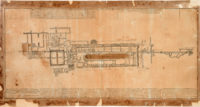 The Getty Villa in Malibu, built to house oil billionaire J. Paul Getty’s extensive collection of antiquities, is a replica of the Villa dei Papyri, a huge, ultra-luxurious home discovered in Herculaneum in the 18th century. The collection has only grown in size and quality since the Getty Villa was completed in 1974, and the museum has hosted a myriad world-class exhibitions of artifacts on loan from all over the world. Only an exhibition dedicated to the model for the Getty Villa was lacking, and there has never been an exhibition dedicated solely to the Villa dei Papyri exhibition anywhere.
The Getty Villa in Malibu, built to house oil billionaire J. Paul Getty’s extensive collection of antiquities, is a replica of the Villa dei Papyri, a huge, ultra-luxurious home discovered in Herculaneum in the 18th century. The collection has only grown in size and quality since the Getty Villa was completed in 1974, and the museum has hosted a myriad world-class exhibitions of artifacts on loan from all over the world. Only an exhibition dedicated to the model for the Getty Villa was lacking, and there has never been an exhibition dedicated solely to the Villa dei Papyri exhibition anywhere.
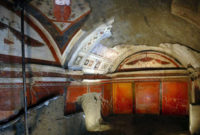 It is more than appropriate, therefore, that the first one of its kind would debut at the Getty Villa. Buried by Vesuvius: Treasures from the Villa dei Papiri runs through October 28th and features a breathtakingly beautiful assemblage of statuary in bronze and marble, frescoes, engravings and artifacts from the villa or associated with its study.
It is more than appropriate, therefore, that the first one of its kind would debut at the Getty Villa. Buried by Vesuvius: Treasures from the Villa dei Papiri runs through October 28th and features a breathtakingly beautiful assemblage of statuary in bronze and marble, frescoes, engravings and artifacts from the villa or associated with its study.
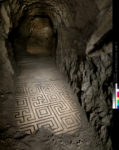 The Villa dei Papyri was discovered by well-diggers quite by accident in 1750. It was excavated by Karl Jakob Weber, a Swiss military engineer who was charged by Charles III of Naples with the first organized excavations of Pompeii and Stabiae as well as Herculaneum. In keeping with his education a an architect and engineer, Weber took a systematic approach to excavation, as opposed to previous diggers who were there to score treasure and gave not a single rat’s ass about the archaeological contexts in which the artifacts they plundered had
The Villa dei Papyri was discovered by well-diggers quite by accident in 1750. It was excavated by Karl Jakob Weber, a Swiss military engineer who was charged by Charles III of Naples with the first organized excavations of Pompeii and Stabiae as well as Herculaneum. In keeping with his education a an architect and engineer, Weber took a systematic approach to excavation, as opposed to previous diggers who were there to score treasure and gave not a single rat’s ass about the archaeological contexts in which the artifacts they plundered had 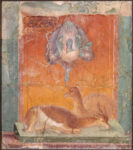 been found. They used tunnels to break through walls and floors, cleaned out whatever they could and bored into the next space. Weber also had to use tunnels as the ancient city was buried under 100 feet of volcanic ash turned to solid rock and there was a modern city on top of it, but he was cautious and deliberate about it, following the architectural layout of the spaces to minimize damage and maximize understanding of the full scope of the massive villa.
been found. They used tunnels to break through walls and floors, cleaned out whatever they could and bored into the next space. Weber also had to use tunnels as the ancient city was buried under 100 feet of volcanic ash turned to solid rock and there was a modern city on top of it, but he was cautious and deliberate about it, following the architectural layout of the spaces to minimize damage and maximize understanding of the full scope of the massive villa.
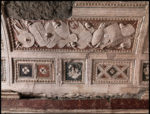 He was also an excellent artist, as luck would have it, and Weber’s drawings of the finds were included in the multi-volume folio of illustrations, Le Antichità di Ercolano, which was a huge hit in mid-18th century Europe and directly influenced the revival of Greco-Roman motifs in the decorative arts.
He was also an excellent artist, as luck would have it, and Weber’s drawings of the finds were included in the multi-volume folio of illustrations, Le Antichità di Ercolano, which was a huge hit in mid-18th century Europe and directly influenced the revival of Greco-Roman motifs in the decorative arts.
 Weber’s floor plan of the Villa dei Papyri, its accuracy confirmed by more recent excavations even as they expanded into previously undiscovered areas, published in Le Antichità was used by architectural firm Langdon and Wilson to create the Getty Villa in Malibu. The unknown details and additional spaces for the museum were based on fully excavated Roman structures from Pompeii, Herculaneum and Stabiae.
Weber’s floor plan of the Villa dei Papyri, its accuracy confirmed by more recent excavations even as they expanded into previously undiscovered areas, published in Le Antichità was used by architectural firm Langdon and Wilson to create the Getty Villa in Malibu. The unknown details and additional spaces for the museum were based on fully excavated Roman structures from Pompeii, Herculaneum and Stabiae.
“The Villa dei Papiri is one of the most luxurious private residences of the ancient classical world ever discovered and one which had an important role in the early history of archeology. Especially important are its unique collection of ancient bronze statuary and antiquity’s only surviving library of papyrus scrolls, which provide an unprecedented insight into the philosophical interests of its aristocratic Roman occupant – none other than the father-in-law of Julius
Caesar,” says Timothy Potts, director of the J. Paul Getty Museum. “Among the most impressive of these finds is a rare bronze sculpture of a drunken satyr, which, as part of a collaborative conservation project with the Museo Archeologico Nazionale di Napoli (MANN), is undergoing analysis and conservation treatment in our conservation studios before going on display in the exhibition.”
Potts adds, “For several decades, we have worked closely with Italian colleagues and institutions in conserving, protecting, researching and celebrating Italy’s extraordinary cultural heritage. We are delighted now to be collaborating with MANN, the Parco Archeologico di Ercolano (PA-Erco), and the Biblioteca Nazionale “Vittorio Emanuele” di
Napoli (BNN) in organizing this exhibition. We have had several successful collaborative conservation projects with MANN over the past few years including, most recently, their monumental funerary vessel (krater) from Altamura in 2018, and three of their splendid bronzes: the Ephebe (Youth) in 2009, the Apollo Saettante in 2011, and the over-life-size sculpture of Tiberius in 2013.”
This video provides a fascinating glimpse into the conservation of the Drunken Satyr. At the end you see a view of the underside which was torn apart by the volcanic impact. It’s amazing how well the bronze survived when you see how Vesuvius battered it.
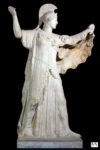
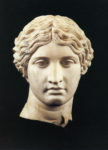
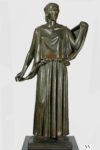
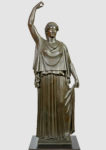


Piglet is adorable. Pooh, Tigger and Eeyore too?
Can someone tell me about the eyes on the bronzes? They are very powerful.
Those eyes were made with glass, and/or –as the caption in the photo indicates– with bone and stone.
The Greek originals can be seen in Athens, check e.g. for the ‘Jockey of Artemision’, where the eyes had unfortunately been lost, or the -much less dynamic- ‘Charioteer of Delphi’.
—————–
PS: Note that I am a bit worried as ‘Tigger’ might be underneath that drunkard 🙁
Thank you, Alf.
The bronzes were probably painted in lifelike colors, which would have made the eyes blend more naturally with the rest of the work.
The Drunken Satyr is amazing–like a cross between Rodin and Carl Milles!